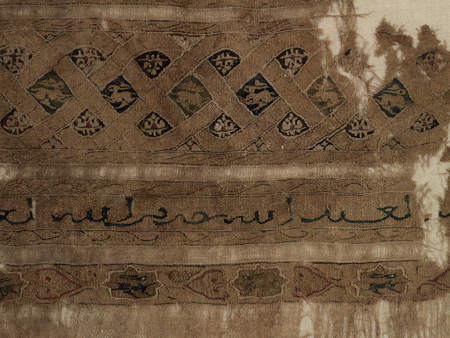ROM Centennial exhibition includes textiles collected by the Museum’s founding director
Many objects on public display for the first time
Opens June 21 in the ROM’s Patricia Harris Gallery of Textiles & Costume
 (Toronto, Ontario – June 11, 2014) Cairo Under Wraps: Early Islamic Textiles, a Centennial exhibition opening at the Royal Ontario Museum (ROM) on June 21, 2014, highlights the ROM’s collection of early Islamic textiles, dating largely from the 8th to 12th centuries. More than half of the exhibition’s approximately 80 fabrics are on public display for the first time and many of the oldest were collected by C.T. Currelly, the ROM`s founding director. These rare, delicate objects are displayed alongside ceramics, glass, metalwork and coins from the ROM’s permanent collection of Islamic art.
(Toronto, Ontario – June 11, 2014) Cairo Under Wraps: Early Islamic Textiles, a Centennial exhibition opening at the Royal Ontario Museum (ROM) on June 21, 2014, highlights the ROM’s collection of early Islamic textiles, dating largely from the 8th to 12th centuries. More than half of the exhibition’s approximately 80 fabrics are on public display for the first time and many of the oldest were collected by C.T. Currelly, the ROM`s founding director. These rare, delicate objects are displayed alongside ceramics, glass, metalwork and coins from the ROM’s permanent collection of Islamic art.
Cairo Under Wraps looks at Islam’s early history and culture through textiles from the first six centuries of Muslim rule. The exhibition illustrates that while earlier civilizations used human figures to convey religious and political messages, Islam used Arabic script as a means of communication and as a primary symbol of the new religious faith. On display are “tiraz” textiles, some of which recorded historical information such as a ruler’s name, date, and place of manufacture. Others conveyed simple expressions of religious faith or simulated Arabic script for decorative purposes.
Exhibition highlights include a rare linen tabby fragment decorated with in-woven silk and gold tapestry bands. Likely the end of a turban cloth, the rope-like design running through the decorative band was highly popular in Egypt inthe 12th century. Other notable objects include a linen tabby with silk tapestry decoration dating to mid-11th century Egypt that features Arabic letters transformed into Nilotic boats, and a stonepaste bowl from late-11th century western Syria decorated with a seated musician dressed in a garment with tiraz bands.
Knowledge about textiles from the early days of Islam comes mainly from Egypt, where fragile materials, including linen, cotton, wool, and silk have been preserved in the dry soil as burial shrouds. These luxury fabrics were likely first used as clothing (such as turbans and robes) and furnishing fabrics (such as curtains and cushion covers). These textiles tell the story of Islam’s far-reaching global trade and taste for high-quality luxury goods.
The exhibition is curated by Anu Liivandi, Assistant Curator (Textiles & Fashions); Dr. Karin Ruehrdanz, Senior Curator (Islamic Decorative Arts); and Dr. Lisa Golombek, Curator Emeritus (Islamic Art).
Cairo Under Wraps is on display until January 25, 2015 in the Patricia Harris Gallery of Textiles & Costume. The exhibition shares the gallery with Fashion Follows Form: Designs for Sitting, featuring fashions from Toronto-based designer Izzy Camilleri whose IZ Adaptive designs are among the first in the world created exclusively for women and men who use wheelchairs. Displayed with Camilleri’s designs are 18th and 19th century fashions from the ROM’s renowned collection, also created for a seated, L-shaped body.
Image Credit
Qasab fragment, Linen tabby. Egypt. 12th century.978.76.188. Abemayor Collection, Gift of Albert and Federico Friedberg
